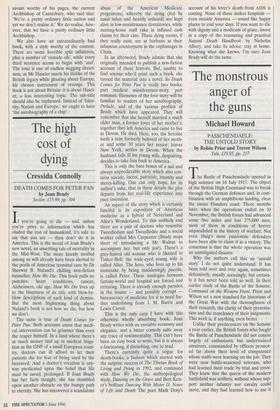The monstrous anger of the guns
Michael Howard
PASSCHENDAELE: THE UNTOLD STORY by Robin Prior and Trevor Wilson Yale, £.19.95, pp. 237 The Battle of Passchendaele opened in high summer on 16 July 1917. The object of the British High Command was to break through the German defences and, in com- bination with an amphibious landing, clear the entire Flanders coast. Three months later, when the operations ended on 10 November, the British forces had advanced some five miles and lost 275,000 men, most of them in conditions of horror unparalleled in the history of warfare. Not even Haig's most passionate defenders have been able to claim it as a victory. The consensus is that the whole operation was an unmitigated disaster.
Why the authors call this an 'untold story' I do not quite understand. It has been told over and over again, sometimes defensively, usually accusingly; but certain- ly it has never been told so well. In their earlier study of the Battle of the Somme, Command on the Western Front, Prior and Wilson set a new standard for historians of the Great War with the thoroughness of their research, the clarity of their presenta- tion and the trenchancy of their judgments. This work is, if anything, even better.
Unlike their predecessors on the Somme a year earlier, the British forces who fought the Battle of Passchendaele did not consist largely of enthusiastic but undertrained amateurs, commanded by officers promot- ed far above their level of competence whose staffs were learning on the job. They were now battle-seasoned veterans, who had learned their trade by trial and error. They knew that the queen of the modern battlefield was artillery, without whose sup- port neither infantry nor cavalry could move, and they had learned how to use it effectively. Huge quantities of guns and shells had been accumulated, the latter no longer the hurriedly produced and unreliable munitions whose inadequacy did so much to explain the failures of the Somme. Liaison with infantry was now meticulous: indeed infantry now had to conform to the timing of the guns, rather than vice-versa. The new techniques were put to the test on 17 June 1917, when Plumer's Second Army seized the strongly held Messines Ridge within six hours, for the loss of 25,000 men. There seemed no reason why this triumph should not be followed by others.
The problem was that such successes were of necessity limited. They had to be followed by long periods of consolidation, while ammunition was replenished, guns were re-ranged and new forces accumulat- ed. A succession of such 'bite and hold' operations, Prior and Wilson suggest, would have made a great deal of sense. But Haig, the cavalryman, wanted to restore a war of movement; and he put in charge of the new offensive not the careful Plumer, but his fellow-cavalryman Hubert Gough, who could be relied upon, not for cautious planning, but `haroosh' — the lordly dis- dain for obstacles developed on the hunt- ing field. Lloyd George, the man ultimately responsible for the conduct of the war, mis- trusted Haig's judgment with good reason, but did not criticise his tactics. He himself
wanted to move the Allied schwerpunkt away from the Western Front altogether, either to Italy or Palestine. But confronted with virtual unanimity among the military that such a move would make no strategic sense, he grudgingly allowed Haig to pro- ceed with the first stages of his offensive, on the understanding that if this did not succeed the operation would be closed down.
It did not succeed, and it was not closed down. The initial plan was over-ambitious. The German defences were too strong, sited in too great depth for British artillery to neutralise them. Artillery support, though massive, still proved inadequate. Communications broke down as they had in all previous offensives; and the heavy rains began that turned the battlefield into the notorious quagmire in which men and horses sank and drowned as in the leg- endary Serbonian bog.
After Gough had failed, Plumer took over and did rather better; but his tech- nique demanded time to prepare each suc- cessive stage, and time was not allowed him. The casualties mounted, the weather grew worse, but Haig battled on, convinc- ing himself that the German Army was on the verge of collapse. The German troops certainly had almost as rough a time at Passchendaele as did the British, but at no time did their morale show signs of break- ing. But it should be remembered, in Haig's defence, that the following year he was equally optimistic and the government equally sceptical, and this time he was right.
Prior and Wilson are, to my mind, entire- ly fair to Haig. He was given a completely free hand. None of his subordinate com- manders questioned either his objective or his methods, which is perhaps to be expect- ed. But after his initial objections, Lloyd George did not either; or if he did question them, he did nothing about it. Having given Haig conditional permission to go ahead, the War Cabinet washed their hands of the battle and barely discussed it, even though they were provided with accurate figures of British losses. There was no political reason why Lloyd George could not have acted: the absence of any serious parliamentary opposition gave him and his colleagues in the War Cabinet virtually carte blanche. If Lloyd George felt as strongly about Haig's conduct of the battle as appears from his memoirs, it is certainly odd that he did nothing about it at the time.
In so far as there is ever likely to be a definitive, balanced and readable history of the Battle of Passchendaele, this will be it. Or it would be, if it were provided with any halfway decent maps.
To order this book at the special discount price of £16.95, call The Spectator Bookshop on 0181 964 9640.



























































 Previous page
Previous page